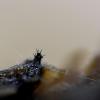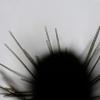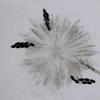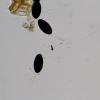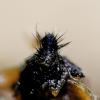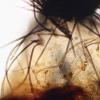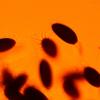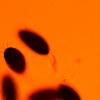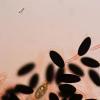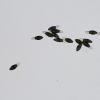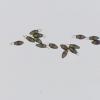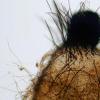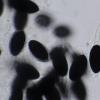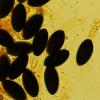
29-03-2025 09:08
 Martine Vandeplanque
Martine Vandeplanque
Bonjour.J’ai essayé d’étudier un Daldinia.Qu

30-03-2025 10:24
Gonzalez Garcia MartaGood morning, I would like to know the opinion of

31-03-2025 17:01
akcay mustafa emreHello everyone, My name is Mustafa Emre Akçay, a

30-03-2025 12:41
Me mandan el material seco de Galicia (España), r

24-03-2025 21:26
Bonjour, J'ai besoin d'une confirmation ou infirm

29-03-2025 06:21
 Francois Guay
Francois Guay
Hi! I found this interesting tiny ascomycete on i

29-03-2025 05:45
Sebastien BassoHello, I'm conducting a mycological inventory in

27-03-2025 22:25
 carl van den broeck
carl van den broeck
On Metzgeria furcata I found hundreds of small whi
This was found on Pony dung.
Perithecium 1mm tall x 0.7mm wide.
Hairs around the neck 67-157 x 3.3-3.7 µm, septate.
Spores 41.9-49.0 x 21.8-23.2 µm. Me = 45.9 x 22.5 (large sample)
Pedicels 34-41 x 5.1-6.4
This seem to fit P. perplexens very well except the spores are a little on the large size according to Ellis & Ellis and Doveri.
I don't have Lundqvist and would be grateful if anyone has it available as a download.
I welcome comments from those with experience of this genus.
Best regards, Chris

We do not distinguish well gelatinous appendages; normally for P.perplexens they are neither ridged or grooved. The top cell of the spore is equilateral and apical pore is eccentric. Furthermore, spore size seems a bit too large for P.perplexens. Try if you can check these characters.
Michel.
Thank you for the quick response.
Unfortunately, I only have the one perithecium, but I did check the spore-sizes and they are accurate. Ideally, I need more material which may appear over the coming days.
Cordialement, Chris

I'll upload it - keep an eye on your emails
best wishes
Chris
PS do you have Mirza & Cain (in Canadian Journal of Botany)?

we informed! To better see appendages trying to color them.
Michel.
No, I don't have Mirza & Cain.
Best wishes, Chris
I have found two more perithecia, both giving similar spore-sizes. Apart from the spores being on the large size, I have since read that P. perplexens is uniseriate and this species is biseriate.
Some more images attached, three in Congo Red. Not very good photos but they do show the appendages opposite the pedicel multi-branched. There is also a long appendage from the pedicel end.
I also have some young spores which are 1-septate.
Regards, Chris

This is certainly the beginning of the appendix once crashed gives the impression that there are several. On your last picture we still see a long upper appendage could be fluted, which would eliminate P.perplexens. Could you observe emplacemement pore at the top of the spore? It also looks like the hairs are located only at the top of perithecia? that correct?
MIchel.

Michel.
I couldn't see an emplacemement pore at the top of the spore. I think a fully mature perithecium would give me a better chance of observing appendages and pores. Those found to date have looked mature but it has been necessary to force the spores from the asci and probably damaging them.
You are correct in saying the hairs are located only at the top of perithecia.
I hadn't considered there being two kinds of spore. They just appeared in the preparation with no evidence of another fungus present. I will investigate further as it's not a genus I have encountered.
Other matters have my attention for a couple of days but I hope to get back to this on Tuesday.
Cordialement, Chris
I have another perithecium but I don't think it adds anything to the discussion. Measurements remain the same including the spores. The spores of this species seem particularly well agglutinated making it difficult to separate them without damage to the appendages.
Cordialement, Chris

regards.
Michel.
Unless I can come up with something more positive, we'll call it a day.
Chris

my best idea is also P. austrohemisphaerica, but this species has much larger spores (54-64 x 31-34µm) and a longer pedicel (until 80 µm). This are own measurements from a german found.
I'm also not sure with the gelatinous equipement of your fungus.
You should try to stain with Indian Ink or Cresyl Blue.
Sorry, but I don't know your interesting Podospora spec.
Regards, Norbert
Thank you for looking at this fungus for me. I don't have information on Podospora austrohemisphaerica but understand it's a recent find written up in Mycologia.
If I find any more I will try Cresyl Blue; I have never used India Ink but will look into getting some.
Regards, Chris

you can get to the protologue via Index Fungorum:
http://www.indexfungorum.org/names/NamesRecord.asp?RecordID=460120
(click on "Page Image . . . . ")
Chris
Also just managed to access it via JSTOR.
Regards, Chris
